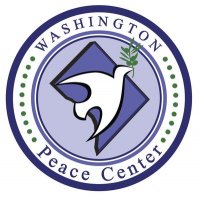The War Resisters League (WRL) is the oldest secular pacifist organization in the United States. The organization is celebrating its centennial from the founding date of October 19 into 2024.
Peace Action is a peace organization whose focus is on preventing the deployment of nuclear weapons in space, thwarting weapons sales to countries with human rights violations, and promoting a new United States foreign policy based on common security and peaceful resolution to international conflicts.
The Movement for a New Society (MNS) was a U.S.-based network of social activist collectives, committed to the principles of nonviolence, who played a key role in social movements of the 1970s and 1980s.
Bill Moyer was a United States social change activist who was a principal organizer in the 1966 Chicago Open Housing Movement. He was an author, and a founding member of the Movement for a New Society.
The Committee for Non-Violent Action (CNVA) was an American anti-war group, formed in 1957 to resist the US government's program of nuclear weapons testing. It was one of the first organizations to employ nonviolent direct action to protest against the nuclear arms race.
New Jewish Agenda (NJA) was a multi-issue membership organization active in the United States between 1980 and 1992 and made up of about 50 local chapters. NJA's slogan was "a Jewish voice among progressives and a progressive voice among Jews." New Jewish Agenda demonstrated commitment to participatory (grassroots) democracy and civil rights for all people, especially those marginalized within the mainstream Jewish community. NJA was most controversial for its stances on the rights of Palestinians and Lesbian and Gay Jews.
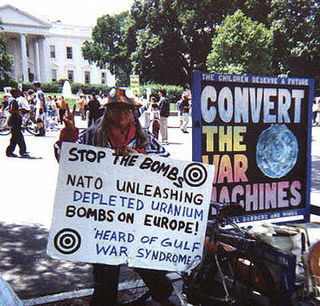
Ellen Thomas is an American peace activist. She first became involved with the White House Peace Vigil on April 13, 1984. The daughter of a US Marine, Thomas was born in Brooklyn and grew up in California. She became opposed to nuclear weapons during her childhood. In protest at the policies of the United States government, she became a tax resister by simply living below the income tax threshold.
Quaker Peace & Social Witness (QPSW), previously known as the Friends Service Council, and then as Quaker Peace and Service, is one of the central committees of Britain Yearly Meeting of the Religious Society of Friends – the national organisation of Quakers in Britain. It works to promote British Quakers' testimonies of equality, justice, peace, simplicity and truth. It works alongside both small local and large international pressure groups.

Women Strike for Peace was a women's peace activist group in the United States. In 1961, nearing the height of the Cold War, around 50,000 women marched in 60 cities around the United States to demonstrate against the testing of nuclear weapons. It was the largest national women's peace protest during the 20th century. Another group action was led by Dagmar Wilson, with about 1,500 women gathering at the foot of the Washington Monument while President John F. Kennedy watched from the White House. The protest helped "push the United States and the Soviet Union into signing a nuclear test-ban treaty two years later". Reflecting the era in which the group's leaders had been raised, between the First-wave feminism and the Second-wave feminism movements, their actions and pleas leaned towards female self-sacrifice rather than towards their own self-interests. However, they pushed the power of a concerned mother to the forefront of American politics, transforming the mother from a "passive victim of war to active fighter for peace".
A Walk of the People – A Pilgrimage for Life was a walking personal and political action organized by peace activists Dale James Outhouse and Pamela Blockey O'Brien to bring attention to the perils of impending nuclear war between the United States and the Soviet Union. Former European Parliament member and French Green Party co-founder Solange Fernex was the European organizer of the project.
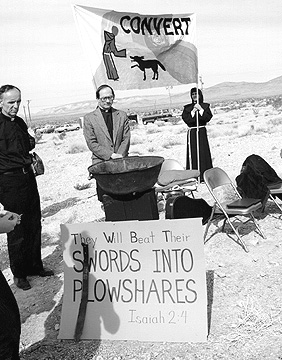
Nevada Desert Experience is a name for the movement to stop U.S. nuclear weapons testing that came into use in the middle 1980s. It is also the name of an anti-nuclear organization which continues to create public events to question the morality and intelligence of the U.S. nuclear weapons program, with a main focus on the United States Department of Energy's (DOE) Nevada National Security Site.
Anti-nuclear organizations may oppose uranium mining, nuclear power, and/or nuclear weapons. Anti-nuclear groups have undertaken public protests and acts of civil disobedience which have included occupations of nuclear plant sites. Some of the most influential groups in the anti-nuclear movement have had members who were elite scientists, including several Nobel Laureates and many nuclear physicists.

A peace movement is a social movement which seeks to achieve ideals such as the ending of a particular war or minimizing inter-human violence in a particular place or situation. They are often linked to the goal of achieving world peace. Some of the methods used to achieve these goals include advocacy of pacifism, nonviolent resistance, diplomacy, boycotts, peace camps, ethical consumerism, supporting anti-war political candidates, supporting legislation to remove profits from government contracts to the military–industrial complex, banning guns, creating tools for open government and transparency, direct democracy, supporting whistleblowers who expose war crimes or conspiracies to create wars, demonstrations, and political lobbying. The political cooperative is an example of an organization which seeks to merge all peace-movement and green organizations; they may have diverse goals, but have the common ideal of peace and humane sustainability. A concern of some peace activists is the challenge of attaining peace when those against peace often use violence as their means of communication and empowerment.
James Peck was an American activist who practiced nonviolent resistance during World War II and in the Civil Rights Movement. He is the only person who participated in both the Journey of Reconciliation (1947) and the first Freedom Ride of 1961, and has been called a white civil rights hero. Peck advocated nonviolent civil disobedience throughout his life, and was arrested more than 60 times between the 1930s and 1980s.

William Thomas Hallenback Jr., known as Thomas, was an American anti-nuclear activist and simple-living adherent who undertook a 27-year peace vigil – the longest recorded vigil in US history at the time, with the title passing to his co-protester Concepción Picciotto after Thomas' death – in front of the White House.

The White House Peace Vigil is an anti-nuclear weapons peace vigil started by William Thomas in 1981. Thomas believed it to be the longest running uninterrupted anti-war protest in U.S. history.
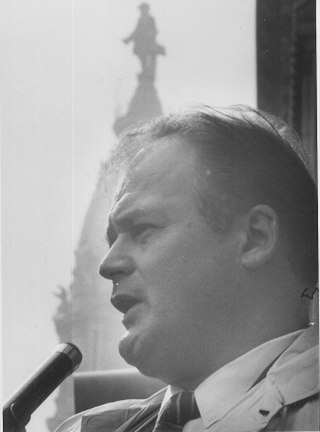
Charles Coates Walker was an American Quaker activist and trainer for nonviolent direct action in both the civil rights and peace movements. He worked throughout his life to bring segregation, racial injustice, nuclear and biological weapons, and war to public awareness. He used Gandhian methods of nonviolence, writing training materials and organizing marches, vigils, protest demonstrations, conferences and campaigns in different parts of the world.
George Russell Lakey is an activist, sociologist, and writer who added academic underpinning to the concept of nonviolent revolution. He also refined the practice of experiential training for activists which he calls "Direct Education". A Quaker, he has co-founded and led numerous organizations and campaigns for justice and peace.
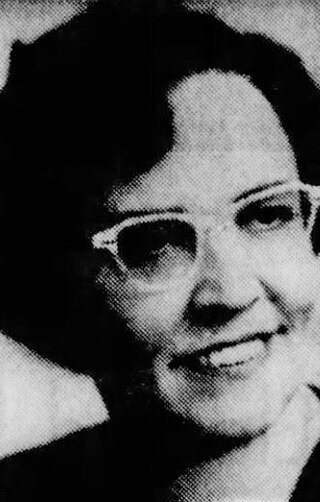
Dorothy Hewitt Hutchinson was an American peace, civil rights and environmental activist, lecturer and author during the twentieth century. An advocate of nuclear disarmament, she became the president of American branch of the Women's International League for Peace and Freedom (WILPF) in 1961 and the international chair of WILPF in 1965, the first American woman to hold that position since Jane Addams co-founded the organization in 1915.
